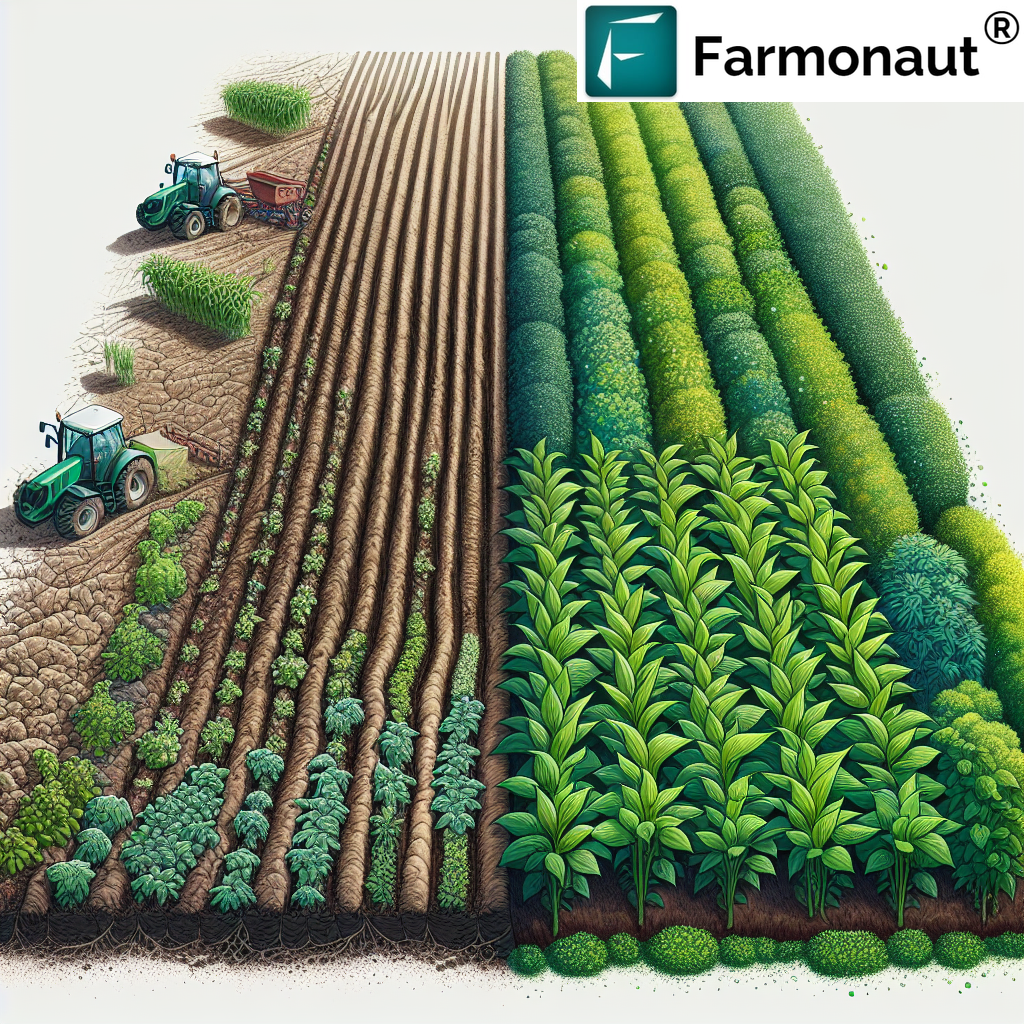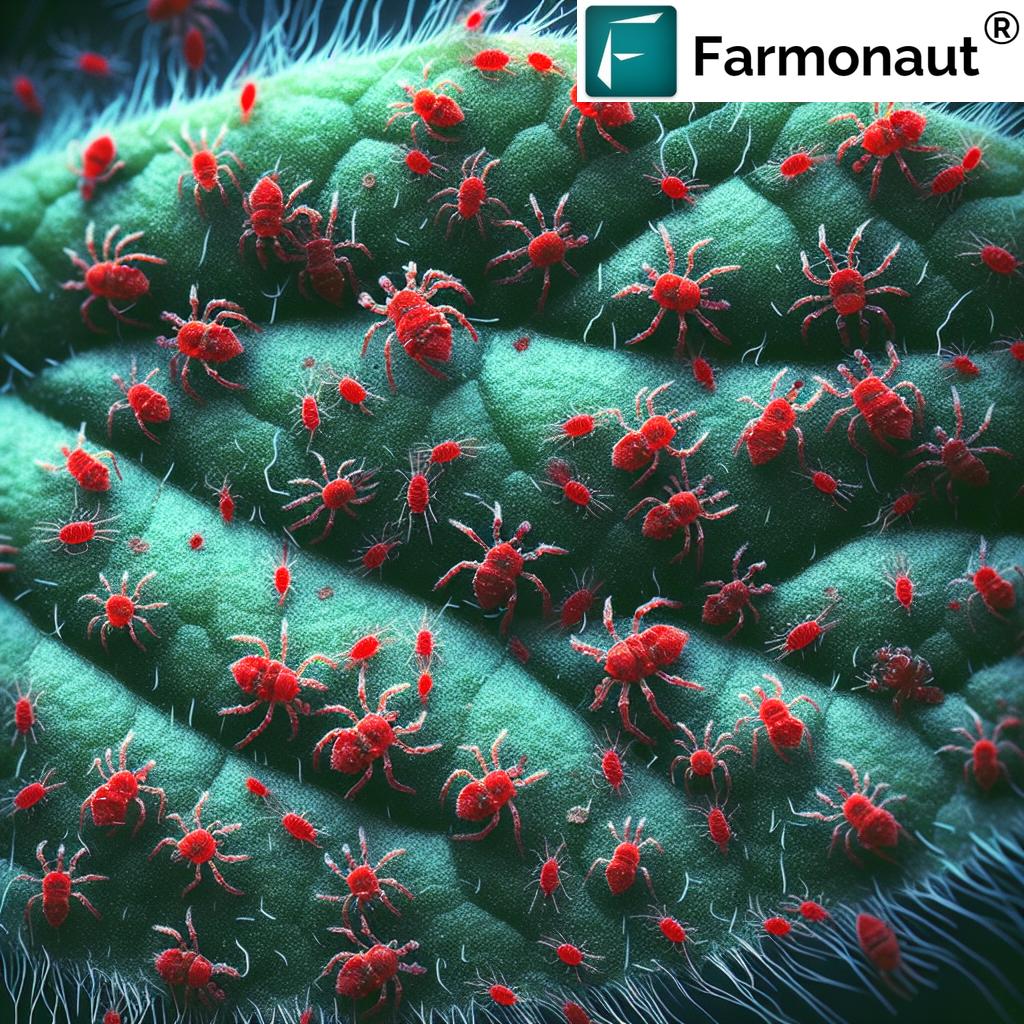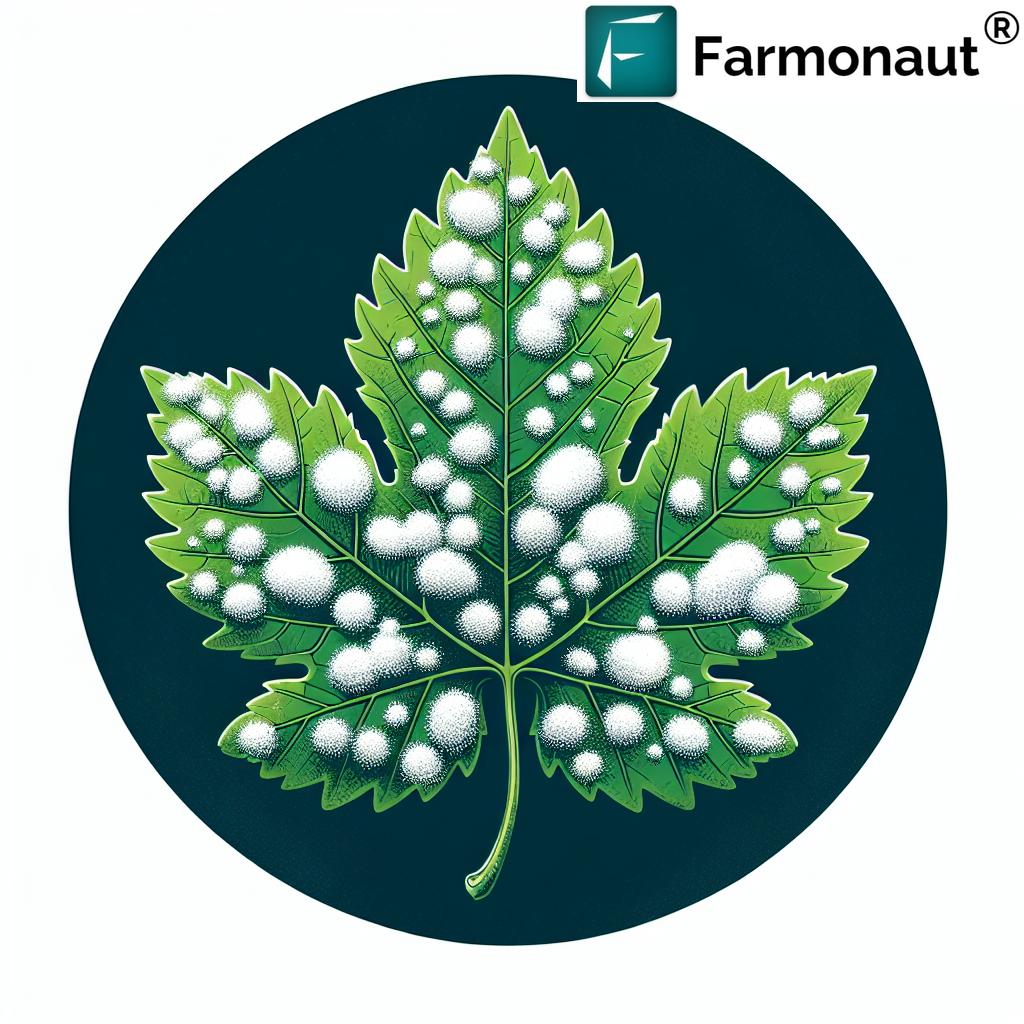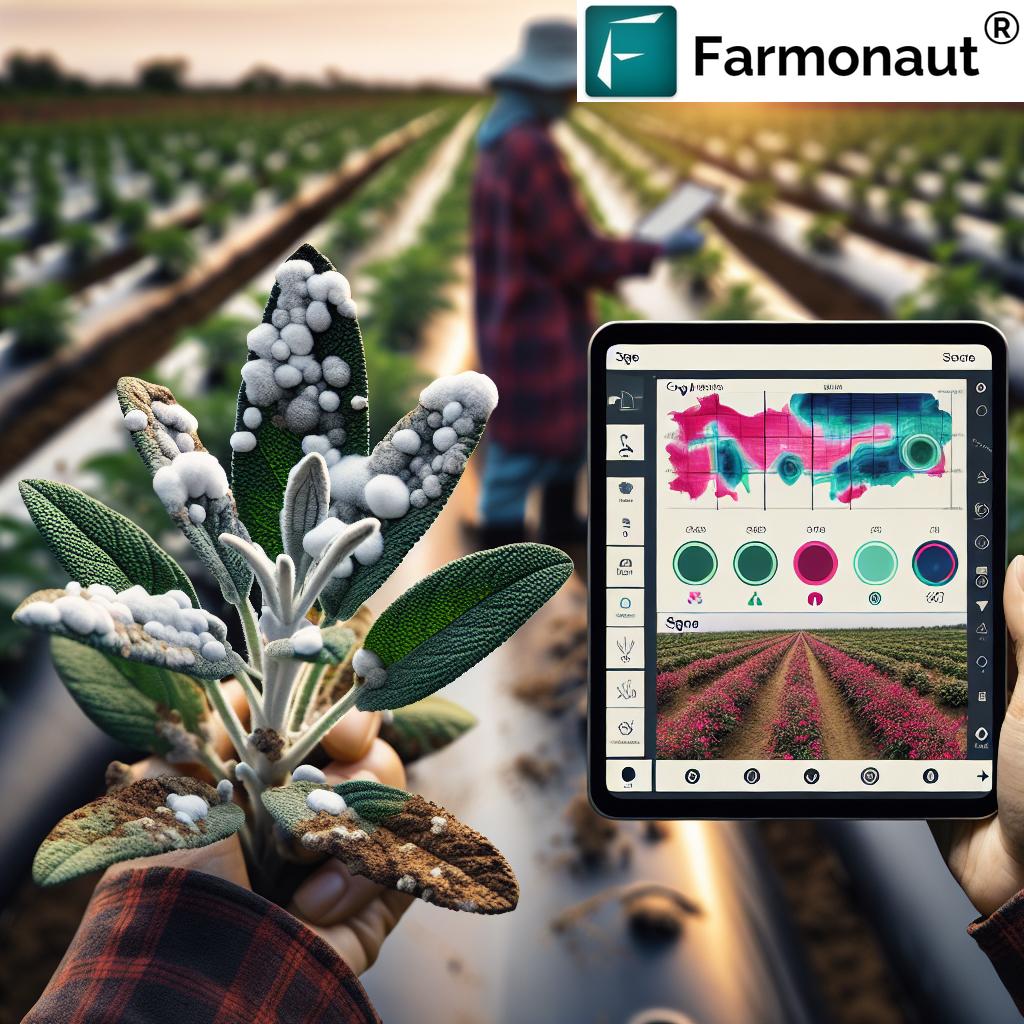Jassid Control: Effective Strategies to Combat Jassid Insects and Nymphs in Tea Plantations

At Farmonaut, we understand the challenges that tea plantation owners and managers face when it comes to pest control. One of the most persistent and damaging pests in tea cultivation is the jassid, also known as the tea jassid. These tiny insects can cause significant damage to tea plants, affecting both yield and quality. In this comprehensive guide, we’ll explore effective strategies to combat jassid insects and their nymphs, with a focus on sustainable and technology-driven solutions.
Table of Contents
- Understanding Jassids: Biology and Behavior
- The Impact of Jassids on Tea Plantations
- Identifying Jassid Infestations
- Integrated Pest Management (IPM) for Jassid Control
- Chemical Control: Jassid Insecticides
- Biological Control Methods
- Cultural Practices for Jassid Management
- Leveraging Technology in Jassid Control
- Farmonaut’s Role in Jassid Management
- Case Studies: Successful Jassid Control in Tea Plantations
- Future Trends in Jassid Management
- FAQs
1. Understanding Jassids: Biology and Behavior
To effectively control jassids, it’s crucial to understand their biology and behavior. Jassids, also known as leafhoppers, belong to the family Cicadellidae. The species that commonly affects tea plantations is Empoasca flavescens, often referred to as the tea jassid.
Life Cycle of Jassids
- Eggs: Female jassids lay eggs inside the leaf tissue or tender stems.
- Nymphs: The jassid nymph stage consists of five instars, each lasting about a week.
- Adults: Mature jassids are small, green, wedge-shaped insects about 3-4 mm long.
The entire life cycle from egg to adult typically takes 3-4 weeks, depending on environmental conditions. Understanding this cycle is crucial for timing control measures effectively.
Behavior and Feeding Habits
Jassids are sap-sucking insects that feed on the undersides of tea leaves. Both adults and nymphs extract plant sap using their piercing-sucking mouthparts. This feeding activity leads to various symptoms and damage to the tea plants.
2. The Impact of Jassids on Tea Plantations
The presence of jassids in tea plantations can have severe consequences for both the quantity and quality of tea production. Let’s examine the various ways in which these pests affect tea plants:
Direct Damage
- Leaf curling: As jassids feed on the leaf sap, they inject toxins that cause the leaves to curl upwards.
- Chlorosis: Feeding activity leads to yellowing of leaves, reducing photosynthetic capacity.
- Stunted growth: Severe infestations can result in overall stunted growth of the tea plant.
Indirect Damage
- Reduced yield: Damaged leaves produce less harvestable tea, leading to significant yield losses.
- Quality deterioration: Affected leaves produce lower quality tea, impacting flavor and aroma.
- Increased susceptibility: Weakened plants become more vulnerable to other pests and diseases.
Economic Impact
The economic consequences of jassid infestations can be substantial. Studies have shown that severe jassid attacks can lead to yield losses of up to 50% in tea plantations. This translates to significant financial losses for tea growers and can have ripple effects throughout the tea industry supply chain.
3. Identifying Jassid Infestations
Early detection of jassid infestations is crucial for effective control. Here are the key signs to look out for:
Visual Symptoms
- Leaf curling: Upward curling of leaves, especially at the margins.
- Chlorosis: Yellowing of leaves, often in a V-shaped pattern.
- Necrosis: Brown, dead patches on leaves in advanced stages.
- Stunted shoot growth: Reduced growth and vigor of new shoots.
Insect Presence
- Adults: Look for small, green, wedge-shaped insects on the undersides of leaves.
- Nymphs: Jassid nymphs are smaller and lighter in color than adults.
- Rapid movement: Jassids quickly move sideways when disturbed.
Monitoring Techniques
- Visual inspection: Regular scouting of tea bushes, focusing on the undersides of leaves.
- Sticky traps: Yellow sticky traps can help monitor adult jassid populations.
- Sweep nets: Useful for collecting and counting jassids in a given area.
At Farmonaut, we recommend implementing a systematic monitoring program to track jassid populations throughout the growing season. Our satellite-based crop health monitoring system can help detect early signs of stress in tea plantations, which may indicate pest infestations. Learn more about our monitoring solutions here.
4. Integrated Pest Management (IPM) for Jassid Control
Integrated Pest Management (IPM) is a holistic approach to pest control that combines various strategies to manage pest populations effectively while minimizing environmental impact. For jassid control in tea plantations, an IPM approach typically includes the following components:
1. Prevention
- Resistant varieties: Planting tea varieties that are less susceptible to jassid attacks.
- Proper nutrition: Ensuring optimal plant health through balanced fertilization.
- Water management: Maintaining proper irrigation to avoid water stress.
2. Monitoring
- Regular scouting: Systematic field inspections to detect early infestations.
- Threshold-based decisions: Establishing economic thresholds for intervention.
- Technology-aided monitoring: Utilizing satellite imagery and AI for large-scale monitoring.
3. Cultural Control
- Pruning: Regular pruning to improve air circulation and reduce pest habitat.
- Shade management: Optimizing shade levels to create less favorable conditions for jassids.
- Weed control: Removing alternative host plants that may harbor jassids.
4. Biological Control
- Natural enemies: Encouraging populations of predators and parasitoids.
- Biopesticides: Using microbial agents like Beauveria bassiana.
- Habitat manipulation: Creating favorable conditions for beneficial insects.
5. Chemical Control
- Selective insecticides: Using targeted jassid insecticides when necessary.
- Rotation: Alternating between different modes of action to prevent resistance.
- Timing: Applying treatments at the most vulnerable stages of the pest life cycle.
Implementing an effective IPM program requires a deep understanding of the tea ecosystem and the ability to make data-driven decisions. At Farmonaut, we provide advanced tools and insights to support IPM strategies in tea plantations. Our satellite-based monitoring system can help detect pest hotspots and track the effectiveness of control measures over time.
5. Chemical Control: Jassid Insecticides
While IPM emphasizes non-chemical control methods, there are situations where the use of jassid insecticides becomes necessary. Here’s an overview of chemical control strategies for jassid management in tea plantations:
Types of Jassid Insecticides
- Neonicotinoids: Systemic insecticides like imidacloprid and thiamethoxam.
- Pyrethroids: Contact insecticides such as cypermethrin and deltamethrin.
- Organophosphates: Broad-spectrum insecticides like dimethoate.
- Novel chemistries: Newer insecticides with unique modes of action, e.g., flonicamid.
Application Strategies
- Foliar sprays: Direct application to the foliage, targeting the undersides of leaves.
- Soil applications: Systemic insecticides applied to the soil for root uptake.
- Alternate row treatment: Spraying alternate rows to preserve beneficial insects.
Considerations for Chemical Control
- Economic thresholds: Apply insecticides only when pest populations reach damaging levels.
- Resistance management: Rotate between different classes of insecticides to prevent resistance.
- Environmental impact: Choose selective insecticides with minimal impact on non-target organisms.
- Residue management: Adhere to pre-harvest intervals to ensure tea safety.
At Farmonaut, we understand the importance of judicious insecticide use. Our satellite-based crop health monitoring can help identify areas of high pest pressure, allowing for targeted insecticide applications. This approach can significantly reduce overall pesticide use while maintaining effective control.
6. Biological Control Methods
Biological control is an essential component of sustainable jassid management in tea plantations. This approach involves using natural enemies of jassids to keep their populations in check. Here are some key biological control methods:
Natural Predators
- Ladybird beetles: Both adults and larvae feed on jassid eggs and nymphs.
- Green lacewings: Larvae are voracious predators of jassid nymphs.
- Spiders: Various spider species prey on adult jassids.
- Predatory bugs: Species like Orius spp. feed on jassid eggs and nymphs.
Parasitoids
- Egg parasitoids: Tiny wasps that lay their eggs inside jassid eggs.
- Nymph parasitoids: Wasps that parasitize jassid nymphs, eventually killing them.
Entomopathogenic Fungi
- Beauveria bassiana: A naturally occurring fungus that infects and kills jassids.
- Metarhizium anisopliae: Another fungal species effective against jassids.
Enhancing Biological Control
To maximize the effectiveness of biological control agents, consider the following strategies:
- Habitat manipulation: Planting nectar-rich flowers to attract and sustain beneficial insects.
- Reduced chemical use: Minimizing broad-spectrum insecticide applications to preserve natural enemies.
- Augmentative releases: Introducing mass-reared beneficial insects to boost natural populations.
- Conservation biological control: Implementing practices that protect and enhance existing natural enemy populations.
At Farmonaut, we recognize the importance of biological control in sustainable tea production. Our advanced monitoring systems can help track the effectiveness of biological control agents and identify areas where additional interventions may be needed.
7. Cultural Practices for Jassid Management
Cultural practices play a crucial role in managing jassid populations in tea plantations. These methods focus on creating an environment that is less favorable for jassid development while promoting overall plant health. Here are some key cultural practices for effective jassid management:
Pruning and Plucking
- Regular pruning: Maintains an open canopy, reducing humidity and jassid habitat.
- Timely plucking: Removes tender shoots that are attractive to jassids.
- Pruning schedule: Coordinating pruning across the plantation to disrupt jassid life cycles.
Nutrition Management
- Balanced fertilization: Ensures optimal plant health and resistance to pest attacks.
- Avoid excess nitrogen: High nitrogen levels can increase plant susceptibility to jassids.
- Micronutrient supplementation: Addressing deficiencies that may weaken plants.
Water Management
- Proper irrigation: Maintains adequate soil moisture without creating waterlogged conditions.
- Drainage improvement: Prevents water stagnation that can attract jassids.
- Mulching: Helps retain soil moisture and suppress weeds that may harbor jassids.
Weed Management
- Regular weeding: Removes alternative host plants for jassids.
- Cover crops: Planting beneficial cover crops between tea rows to suppress weeds and attract natural enemies.
- Mulching: Suppresses weed growth and conserves soil moisture.
Shade Management
- Optimal shade levels: Maintaining appropriate shade to balance plant health and pest pressure.
- Shade tree selection: Choosing shade trees that don’t serve as alternate hosts for jassids.
- Pruning shade trees: Regular pruning of shade trees to allow adequate light and air circulation.
At Farmonaut, we understand the importance of integrating cultural practices into overall jassid management strategies. Our satellite-based monitoring system can help track the effectiveness of these practices by providing real-time insights into crop health and stress levels. Learn more about our solutions here.
8. Leveraging Technology in Jassid Control
In the modern era of agriculture, technology plays a crucial role in pest management, including the control of jassids in tea plantations. At Farmonaut, we are at the forefront of integrating cutting-edge technologies to enhance pest management strategies. Here’s how technology is revolutionizing jassid control:
Satellite-Based Monitoring
Our advanced satellite monitoring system offers several advantages for jassid management:
- Early detection: Identify areas of stress in tea plantations that may indicate jassid infestations.
- Large-scale monitoring: Cover vast areas of tea plantations efficiently and cost-effectively.
- Temporal analysis: Track changes in crop health over time to assess the effectiveness of control measures.
Artificial Intelligence and Machine Learning
AI and ML algorithms are transforming pest management in the following ways:
- Predictive modeling: Forecast jassid outbreaks based on historical data and environmental factors.
- Image analysis: Automatically detect and quantify jassid damage from satellite and drone imagery.
- Decision support: Provide data-driven recommendations for optimal timing of control measures.
IoT Sensors and Weather Stations
Internet of Things (IoT) devices contribute to jassid management by:
- Microclimate monitoring: Track temperature, humidity, and other factors that influence jassid populations.
- Real-time alerts: Notify plantation managers when conditions are favorable for jassid outbreaks.
- Data integration: Combine sensor data with satellite imagery for comprehensive pest monitoring.
Mobile Applications
Farmonaut’s mobile app empowers tea growers with:
- Field scouting tools: Easily record and geolocate jassid observations.
- Treatment tracking: Log and monitor the effectiveness of control measures.
- Access to expert advice: Connect with agricultural experts for personalized guidance.
Precision Application Technologies
Advanced application technologies improve the efficiency of jassid control:
- Variable rate sprayers: Apply insecticides precisely based on pest pressure and crop health data.
- Drone-based applications: Target specific areas of infestation with minimal environmental impact.
- Smart nozzles: Optimize droplet size and coverage for more effective pest control.
By leveraging these technologies, tea plantation managers can implement more precise, timely, and effective jassid control strategies. At Farmonaut, we continually innovate to provide the most advanced technological solutions for sustainable pest management in tea cultivation.
9. Farmonaut’s Role in Jassid Management
At Farmonaut, we are committed to revolutionizing pest management in tea plantations through our advanced technological solutions. Our comprehensive approach to jassid control integrates satellite technology, artificial intelligence, and expert agricultural knowledge. Here’s how Farmonaut is making a difference in jassid management:
Satellite-Based Crop Health Monitoring
Our state-of-the-art satellite monitoring system provides:
- Early detection: Identify potential jassid infestations before visible symptoms appear.
- Large-scale monitoring: Cover entire tea estates efficiently, regardless of terrain.
- Temporal analysis: Track changes in crop health over time to assess the impact of jassid control measures.
AI-Powered Advisory System
Our Jeevn AI advisory system offers:
- Predictive analytics: Forecast jassid outbreaks based on historical data and current conditions.
- Customized recommendations: Provide tailored advice for jassid control based on plantation-specific data.
- Real-time alerts: Notify plantation managers of potential pest threats and optimal intervention times.
Integrated Data Platform
Farmonaut’s comprehensive data platform enables:
- Data aggregation: Combine satellite imagery, weather data, and field observations for holistic pest management.
- Historical analysis: Access long-term data to understand pest patterns and optimize control strategies.
- Collaborative planning: Share insights and coordinate pest management efforts across large estates.
Mobile Application
Our user-friendly mobile app provides:
- On-the-go monitoring: Access real-time crop health data and pest alerts from anywhere.
- Field scouting tools: Record and geolocate jassid observations directly in the app.
- Treatment tracking: Log and evaluate the effectiveness of jassid control measures.
API Integration
Farmonaut offers API access for seamless integration with existing farm management systems:
- Custom solutions: Tailor our satellite and weather data to specific plantation needs.
- Automated workflows: Integrate pest management data into broader farm operations.
- Third-party compatibility: Connect with other agtech tools for comprehensive farm management.
By leveraging Farmonaut’s advanced technologies, tea plantation managers can implement more precise, timely, and effective jassid control strategies. Our solutions not only help in managing current infestations but also in preventing future outbreaks through proactive monitoring and data-driven decision-making.
To learn more about how Farmonaut can revolutionize jassid management in your tea plantation, visit our website or download our mobile app:
10. Future Trends in Jassid Management
As we look to the future of jassid management in tea plantations, several emerging trends and technologies promise to further enhance our ability to control these pests effectively and sustainably. At Farmonaut, we are at the forefront of these innovations, continuously evolving our solutions to meet the changing needs of tea growers. Here are some key trends to watch:
1. Advanced Remote Sensing Technologies
- Hyperspectral imaging: Detect subtle changes in plant physiology indicative of early jassid infestations.
- Thermal imaging: Identify stress patterns in tea plants that may be caused by jassid feeding.
- LiDAR technology: Create 3D models of tea plantations for more precise pest monitoring and management.
2. Artificial Intelligence and Machine Learning
- Automated pest identification: Develop AI models capable of identifying jassids and their damage from images.
- Predictive modeling: Enhance forecasting of jassid outbreaks based on complex environmental and biological factors.
- Personalized management plans: Generate tailored jassid control strategies for individual plantation blocks.
3. Precision Agriculture Tools
- Variable rate technology: Apply insecticides and nutrients with precision based on real-time pest pressure data.
- Autonomous sprayers: Develop self-driving sprayers capable of targeted pesticide application.
- Micro-dosing systems: Deliver precise amounts of pest control agents to reduce environmental impact.
4. Biotechnology and Genetic Engineering
- Resistant tea varieties: Develop tea plants with enhanced natural resistance to jassids.
- RNA interference (RNAi): Explore gene silencing techniques to control jassid populations.
- Pheromone-based control: Utilize synthetic pheromones for mating disruption or mass trapping of jassids.
5. Integrated Data Ecosystems
- Blockchain for traceability: Implement blockchain technology to track pest management practices and ensure compliance.
- Big data analytics: Leverage vast datasets to uncover new insights into jassid behavior and control.
- IoT integration: Connect various sensors and devices for comprehensive, real-time monitoring of pest populations and environmental conditions.
6. Sustainable and Eco-friendly Approaches
- Biopesticide development: Research and develop new, environmentally friendly pest control agents.
- Conservation biological control: Enhance habitats for natural enemies of jassids within tea plantations.
- Agroecological approaches: Implement holistic farming systems that naturally suppress jassid populations.
At Farmonaut, we are actively researching and developing solutions that incorporate these emerging trends. Our goal is to provide tea growers with the most advanced, efficient, and sustainable tools for jassid management. By staying at the forefront of technological innovation, we ensure that our clients are well-equipped to face the pest management challenges of today and tomorrow.
11. FAQs
Here are some frequently asked questions about jassid management in tea plantations:
Q1: What are the first signs of a jassid infestation in tea plants?
A1: The first signs of jassid infestation typically include upward curling of leaf margins, yellowing of leaves (chlorosis), and the presence of small, green, wedge-shaped insects on the undersides of leaves.
Q2: How do jassids damage tea plants?
A2: Jassids damage tea plants by sucking sap from the leaves, which leads to leaf curling, chlorosis, and stunted growth. They also inject toxic saliva while feeding, causing further damage to plant tissues.
Q3: What is the economic threshold for jassid control in tea plantations?
A3: The economic threshold can vary depending on local conditions, but generally, control measures are recommended when there are 2-3 jassids per leaf on average, or when 15-20% of leaves show damage symptoms.
Q4: Are there any natural predators of jassids in tea plantations?
A4: Yes, several natural predators feed on jassids, including ladybird beetles, green lacewings, spiders, and predatory bugs. Encouraging these beneficial insects can help in natural jassid control.
Q5: How effective are chemical insecticides in controlling jassids?
A5: Chemical insecticides can be effective in controlling jassid populations when used judiciously. However, their use should be balanced with other IPM strategies to prevent resistance development and minimize environmental impact.
Q6: Can cultural practices alone effectively control jassid populations?
A6: While cultural practices like proper pruning, nutrition management, and weed control are essential for jassid management, they are most effective when combined with other IPM strategies for comprehensive control.
Q7: How does Farmonaut’s satellite monitoring help in jassid management?
A7: Farmonaut’s satellite monitoring system helps detect early signs of crop stress that may indicate jassid infestations. It allows for large-scale, efficient monitoring of tea plantations, enabling timely interventions and targeted control measures.
Q8: Are there any organic methods for controlling jassids in tea plantations?
A8: Yes, organic methods include the use of neem-based products, entomopathogenic fungi like Beauveria bassiana, and encouraging natural predators. These methods can be effective when used as part of a comprehensive organic pest management strategy.
Q9: How often should tea plantations be monitored for jassid infestations?
A9: Regular monitoring is crucial. We recommend weekly scouting during peak infestation periods and bi-weekly during other times. Farmonaut’s satellite monitoring provides continuous oversight, complementing on-ground observations.
Q10: Can weather conditions affect jassid populations in tea plantations?
A10: Yes, weather conditions significantly influence jassid populations. Warm, dry weather typically favors jassid reproduction and spread. Farmonaut’s weather API can help predict favorable conditions for jassid outbreaks, allowing for proactive management.
For more information on how Farmonaut can help you manage jassid infestations in your tea plantation, please visit our website or contact our team of experts.
Conclusion
Effective jassid management is crucial for maintaining the health and productivity of tea plantations. By integrating traditional pest control methods with advanced technologies like satellite monitoring and AI-driven analytics, tea growers can significantly improve their ability to detect, prevent, and control jassid infestations.
At Farmonaut, we are committed to providing cutting-edge solutions that empower tea plantation managers to make data-driven decisions and implement targeted pest management strategies. Our comprehensive approach, combining satellite technology, artificial intelligence, and expert agricultural knowledge, offers a powerful toolkit for sustainable and efficient jassid control.
As we look to the future, the integration of emerging technologies and sustainable practices will continue to revolutionize pest management in tea cultivation. By staying at the forefront of these innovations, we can ensure the long-term health and productivity of tea plantations while minimizing environmental impact.
To learn more about













